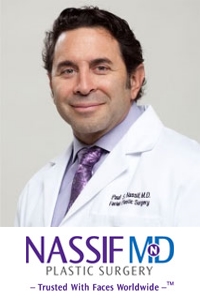NoseComfort Commendation From Dr. Paul S. Nassif
"As I entered the exam room, I did a double-take when I saw the support on her forehead; her glasses were supported perfectly and there was no pressure on the nose. I immediately saw the potential of this product."
by Paul S. Nassif, M.D.

Please let me introduce myself. My name is
Dr. Paul S. Nassif, and my practice is located in Beverly Hills, California. My primary area of focus is revision rhinoplasty. In 2010, I performed a septorhinoplasty on a female patient. This patient wore glasses, and I instructed her to tape the glasses to her forehead to prevent them from coming into contact with her nose during the initial healing process.
The patient soon discovered that the tape would not adhere to her face. She mentioned the problem to her husband, who had an engineering background. He saw what was needed and purchased some plastic at a local hobby shop. He fashioned a T-shaped piece of plastic with a hook at the center. This hook would support the bridge of the glasses and prevent them from touching the nose. He went to a local fabric store and found elastic bra-strap material, which was attached to each end of the T-section. A piece of foam rubber was then attached to the back of the support.
When the patient returned for her one month follow up appointment, she was wearing the eyeglass support. As I entered the exam room, I did a double-take when I saw the support on her forehead; her glasses were supported perfectly and there was no pressure on the nose. I immediately saw the potential of this product. The patient’s husband had accompanied her and made an extra eyeglass support for me. I was eager to learn the details on how the support was made, and wanted to see how more could be produced. Over the next few months, we worked together on a number of prototypes until we arrived at a final design. Once we had this design, a patent attorney was contacted and a patent application was filed.
All of the prototypes were hand-formed. In order to mass produce the eyeglass support, both an automated forming machine and supporting machine had to be designed and built. This required us to find a team of engineers who specialize in automation of this type of product.
It took a while, but you now see the finished product that I have dispensed to my patients. The eyeglass support works far better than adhesive tape, and helps to address the issues that may arise when patients do not follow my post-operative instructions.
Sincerely,
Paul S. Nassif, M.D., F.A.C.S.
|